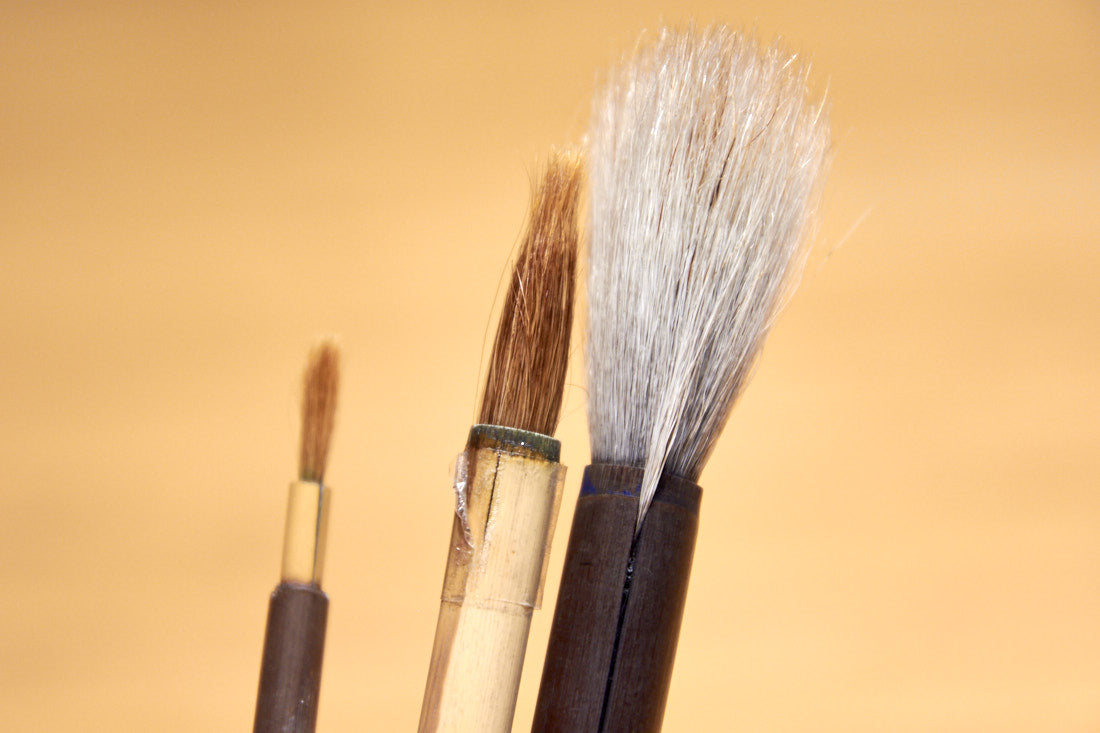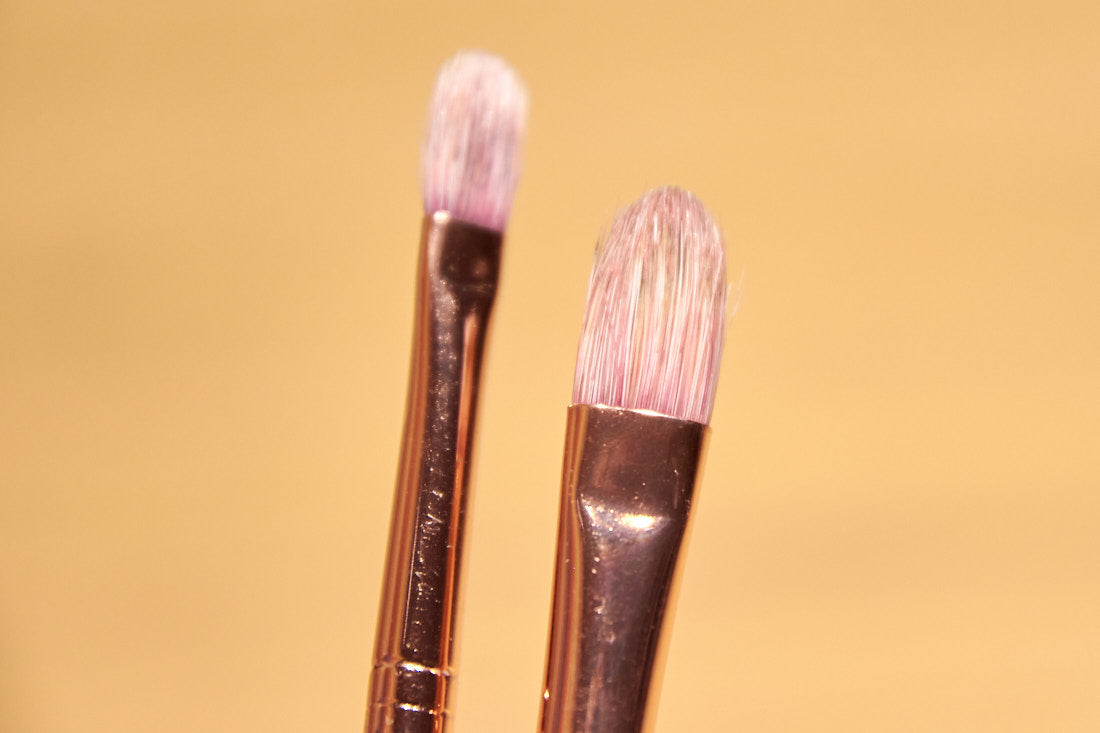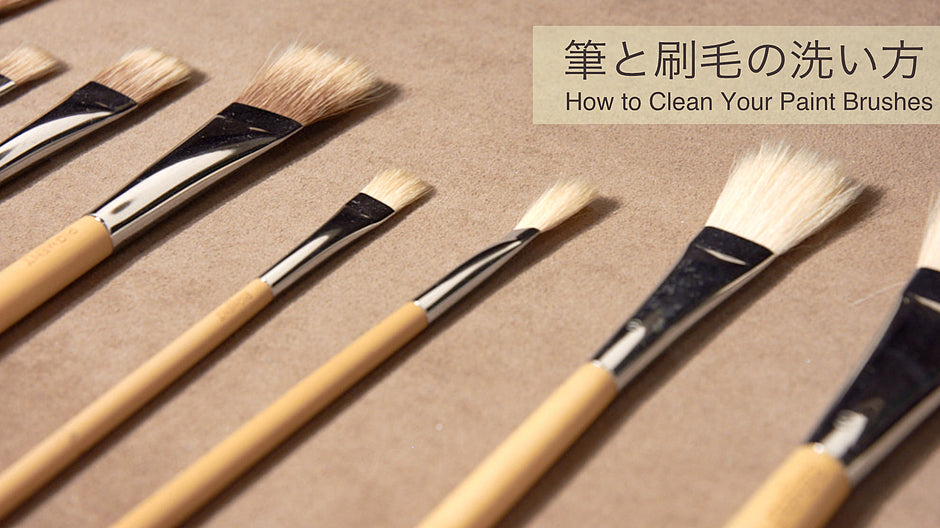Kukai (空海), a Japanese Buddhist monk during the Heian period (794-1185), wrote in his Shoryo-Shu (性霊集), "A skilled artisan uses the chisel handily to carve while a great calligrapher uses the finest brush to write."
In other words, no matter if you bought the best quality brush, if it is not taken good care of, you will not be able to use it to its full potential.
Have you ever had an experience where the heel of a cleaned kolinsky sable-hair brush cracked like this, or a pig-hair brush was not cleaned properly so the bristle sticks together?


The brush is the life of a painter. I’m sure you’d want to take good care of each paintbrush and use it pleasantly every time. In this article, PIGMENT TOKYO is here to show you how to take care of your brushes.
First of all, if you use oil paints, it is best to prepare a brush cleaning solution or soap with surfactants.
If you are using water-based paints and brushes made of animal hair, you can use a puppy shampoo to clean them.
Of course, it is possible to substitute puppy shampoo for hand soap, hair shampoo, dishwashing detergent, and so on. However, please be aware that some of them may cause damage or problems to the bristles, such as making the bristles less flexible, foaming up too much to clean the brushes well, or losing the smoothness of the brush hairs, etc.
If you couldn’t find yourself the perfect cleaning solution for each brush, we recommend the DUO Brush Cleaner, which can be used for both oil-based and water-based paints, including transparent watercolor and acrylic paints.
In addition to the products introduced and mentioned in this article, no doubt there are many other "brush cleaning solutions" available from various manufacturers, hope you find the one that matches your daily drawing life.
So, let me show you how to clean your brushes step by step.
1) Remove most paint on the brushes.
In the case of oil-based mediums, use a volatile oil such as mineral spirits (petroleum spirits) to thoroughly remove paint and stain.
If you use mineral spirits for cleaning, wipe it off with a rag so that the solvent does not remain on the brush.
For water-based mediums, you can just use water to clean your brush.
2) Remove paint with a brush cleaner.
Prepare a bowl or small plate of brush cleaner, and gently wash your brush with it to remove the paint.
There’s no need to refill the brush cleaner for each brush, but if you feel that the solvent is tinted and paint is not removed well , please pour it out and fill it with a new one.

3)Clean your brush by rinsing with water.
Use running water to thoroughly remove the paint from the belly of the brush.
If there are still stains left on the bristles at this point, go back to the process ② and wash your brush again with the cleaner.
Moreover, once the acrylic or oil paints have dried and hardened, they can’t be washed off unless you use a special solvent such as a paint remover.
Brushes can easily become hard and be damaged , so be sure to clean them thoroughly every time.
Also, in general, the detergent or cleaner is more effective when it comes to a higher temperature, so it will be better and easier to clean your brushes with warm water which is about as warm as the human touch.
(However, if the temperature is over 60 degrees Celsius, the effectiveness of cleaning may reduce.)

4)Let it dry.
Drain off the water with a rag, dry your brushes off, and you're done....or not??
I would like to say your job is done here but actually the drying process is the most important part of brush cleaning.
When drying the brush, if you put your brushes straight back it up in a bottle like the picture below or place it on a rag, the moisture will still remain in the joint of the hairs and handles of the brush and cause the wooden part to crack.

Therefore, when drying your brushes, keep the bristles facing down if possible.
For example, the Painting Brush in the picture below, there is a string threaded through the handle, so you can hang it on an S-hook to dry.

For brushes with round handles or brushes that do not have a string attached, you can use a clothespin with a hook to hold the handle and hang it on a rack like in the picture below.
In PIGMENT TOKYO, we use and wash tons of brushes all the time, so we have ourselves a drying rack on the wall in the staffroom.

There are many kinds of ways for you to keep and dry your brushes, for example, storage boxes for industrial brushes, makeup brush holders for cosmetics, and bamboo brush racks for calligraphy, but it is also possible to substitute with everyday items.
Such as, you can use small metal drying racks that can be found in hardware stores or dollar shops, which are customizable in width and height, and maybe easier to install or move around than ready-made ones.
Do note that paintbrushes are consumable items.
Keeping your tools in a good condition will not only prevent them from wearing out but will also give you a better idea of when it’s time to replace them.
In the famous Japanese essay "Tsurezuregusa (徒然草), known as Essays in Idleness", paragraph 185, it says, "A gifted horseman named Adachi Yasumori could tell whether a horse is fit or not by just watching it run. In other words, if he hadn’t given all in and been a master of horse, he would not have developed such cautiousness and ability.”
Therefore, as an artist, we should maintain and continue to use our tools carefully, and hope to develop an aesthetic eye that can distinguish good quality brushlike how Adachi Yasumori did to the horse.
References
《The Collected Works of Masahiro Endo, Four Treasures of the Study 1, Brushes(1)》Masahiro Endo
http://yurinsha.net/emchosaku/bunnbousihou1.html
(Viewed on March 26, 2021)
Yoshida Kenkō’s《Tsurezuregusa (Essays in Idleness) 》, translated by Toshiaki Azumama
https://tsurezuregusa.com/185dan/
(Viewed on March 26, 2021)

